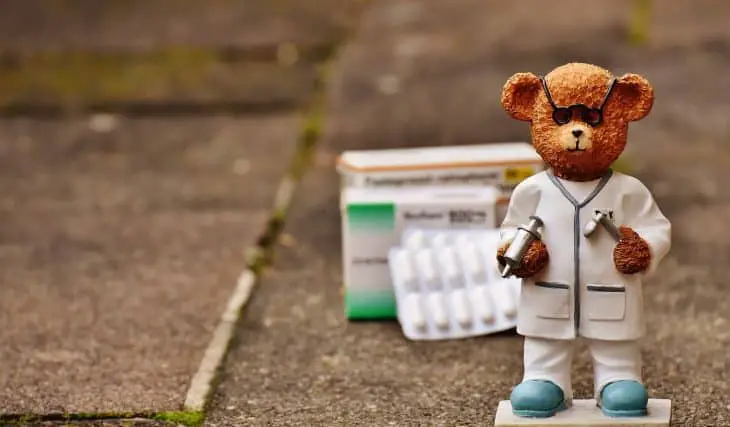
Tongue is a perfect health indicator and will alert you with various signs of any health problems: spots, dots and coating on the surface. Sometimes these signs can be scary, but you better need to know what caused their appearance and how to treat them.
Black Spots on the Baby’s Tongue – What are They?
An absolutely healthy baby will usually have a pink tongue of a neutral color. But from time to time you can notice some spots of different color. Brown or black dots on the baby’s tongue can appear because of several reasons:
- They are more likely spots of baby’s pigmentation, usually inherited from the darker-skinned parents;
- They are small blood clots from irritation;
- They appear after taking iron vitamins and supplements;
- They are stains from the growing bacteria.
How can Bacteria Grow on Baby’s Tongue?
The surface of the tongue is covered with many tiny projections – papillae, that contain taste buds. Some papillae are longer than others and can easily hold anything: dead skin cells, bacteria, yeast and food substances.
The overgrowth of the papillae can be excessive, and it may even look hairy and in different colours: black, brown, tan, green, yellow or white.
How Black Hairy Patches Develop on Baby’s Tongue?
Black hairy spots are harmless, though they look really scary. It is a temporary oral condition, caused by yeast and should be treated as oral thrush infection. It can be different in colour.
Sometimes black colour of thrush infection can be caused by gripe water, especially of the Wellements brand.
The biopsy results usually show mixed bacterial and fungal colonization.
What are the Signs of Oral Thrush?
Usually white but sometimes different colour spots on baby’s tongue is a sign of oral thrush, when yeast infection develops in baby’s mouth. This may look like cottage cheese and can be also seen elsewhere in the mouth.
Healthy babies may have this fungus and it does not bother them. But when the fungus overgrows, it may affect your baby and you will need to take an action.
How can I Treat the Oral Thrush?
If any of the above signs on your baby’s tongue does not rub or wipe off easily, please do not worry but try an antifungal medication.
You can start an antifungal medication, which usually doctors recommend for babies: Miconazole Daktarin Oral Gel or Nystatin Suspension.
Apply very little amount of Miconazole Gel in your baby’s mouth with a clean finger after every feeding. Keep giving medication for 2 more days after the infection cleared up to prevent its return.
If the thrush has not gone after a week of treatment, or if you notice any side effects, go for doctor’s advice.
As an alternative medication, Nystatin Suspension can also be applied directly with a dispenser to the affected areas. Nystatin doesn’t usually cause any side effects and most babies have no trouble taking it.
When should I Ask for Doctor’s Advice?

Oral thrush in babies is not usually serious, as long as your baby is not acting sick. But when your baby rejects feeding and its mouth is sore, this infection needs to be treated. You should ask for doctor’s advice and even send a swab from baby’s mouth for a test.
It really should be taken seriously if the fungus does not clear up after 7-day treatment.
Why do some Babies Develop Oral Thrush?
- Baby’s’ immune system hasn’t fully developed and not able to resist thrush infection. Especially, you should be more careful if your precious one was born prematurely, before 37 weeks.
- If you recently gave your baby antibiotics, it will also increase fungus infection in your baby’s mouth, because antibiotics normally reduce levels of healthy bacteria.
- If you recently took antibiotics yourself and breastfeed now, then you could be affected by a thrush infection and pass it to your baby during breastfeeding.
Advice for Mothers – Take Care of Yourself
If you breastfeed, wash your nipples after and before feeding every time in this case. I always used Lansinoh Disposable Nursing Pads to help me protect clothes and keep it dry and clean.
If your baby has oral thrush infection it can pass it to you. This may affect your nipples or breasts and cause nipple thrush. In this case, you should also treat the infection and apply a Miconazole Cream to your nipples after every feed and remove anything left before the next feed.
In severe overgrowth of the bacteria in your baby, ask your doctor what antifungal tablets he would recommend for you.
Also include into your daily meal yogurt and probiotics Prenatal Probiotics for Pregnant and Nursing Women to balance your and baby’s immune systems properly.
How to Prevent Oral Thrush in Babies?
It is believed that it is absolutely impossible to prevent Oral Thrush in babies.
Sometimes, when you give your baby plain water after a feed, it may help to rinse away the rest of the milk in baby’s mouth, to prevent growing of fungus.
Some doctors suggest sterilising everything: baby’s bottles, equipment, toys, etc. Others are more relaxed on this and advise just to clean supplies thoroughly with running water.
Not sterilizing will leave some useful bacteria on the surface of baby’s equipment to contact with the baby to help develop immune shield in its body naturally. But you should also understand that too much bacteria can be too bad for the baby.

